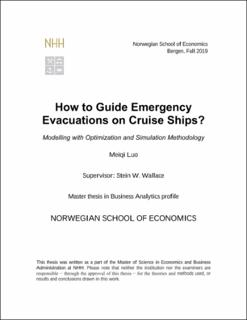| dc.description.abstract | In recent years, the number of cruising tourists has been growing rapidly, but some serious
cruise ship accidents have also aroused safety concerns of the public on travelling with
cruise ships. However, the fixed emergency evacuation routes that are suggested in a
boarding drill or pasted behind a cabin door is inapplicable in a real emergency because of
ignoring the uncertain influence of the hazards. The existing research about emergency
evacuation on vessels is rare, and how to guide the evacuees under emergency situations is
also seldom mentioned. Moreover, modelling the evacuation on ships also needs to
consider unique features of ships, such as unstable conditions during emergencies,
including shaking, heeling and sinking, and the confined steel environment on ships, where
internal data communication is totally dependent on cables.
In this thesis, an implementable evacuation guiding model is proposed. In the proposed
model, differentiated evacuation routes are suggested to evacuees with consideration of
different movability and walking speed of them. In addition, the guiding of evacuees is
also realizable in the proposed model, with the cutting-edge sensor mesh technology
developed by ScanReach, with which the wireless data transfer in confined steel
environments is feasible. The proposed model is simulated in a framework of rolling
horizon, updating the dynamics of an emergency evacuation by continuously gaining the
latest information of hazard situation and evacuees movements.
Keywords: evacuation, guide, cruise, vessel, ship, fire, hazard, uncertainty, rolling horizon. | en_US |
